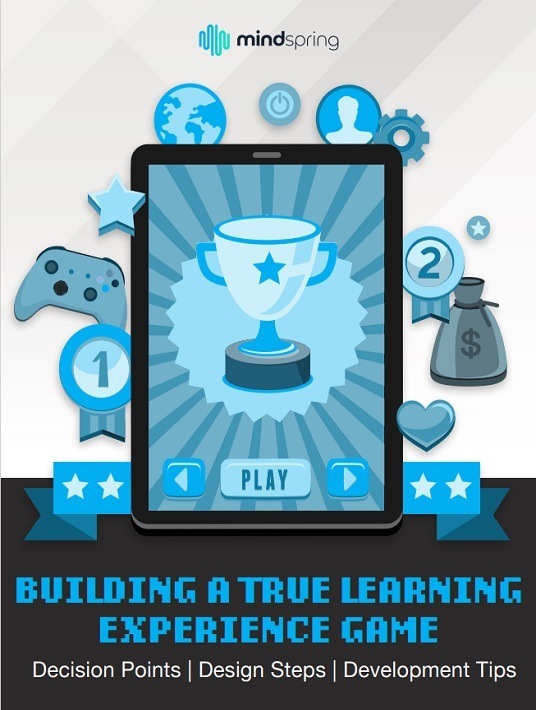Are Training Games The Right Approach?
This article is part of a series on building a true training game to increase managers’ understanding of corporate finance. What you are about to read is a fable. The company, AshCom, is fictional, but the learning challenges faced by Kathryn, AshCom’s CLO, and her team are real and commonly shared by learning teams in large organizations. It is our hope that you will be able to connect with the characters, their challenges, and the solutions they discover. We also invite you to read the first eBook in the series.

Ready For The Weekend
Check, check, check, and check. Kathyrn went through her mental list of items she needed to pack for the upcoming weekend: a cooler full of water, an umbrella, hand warmers, and stadium chairs. As soon as she entered the sports complex address in her maps app, they were on their way. She smiled in anticipation of the weekend; she always loved a good game.
Kathryn and her husband, Bill, had gotten used to spending weekends on the road. Their daughter Olivia was now in her final year of high school and was as serious about sports as Kathryn had been when she was in high school.
Kathryn and Bill were thrilled when Olivia signed a letter of intent to play for the University of Minnesota. Kathryn also played college softball but for a much smaller school. Olivia’s offense and defensive abilities had gotten the attention of several Division I schools. College coaches started to come to her games when she was a junior. They stayed in contact with her high school coach and paid attention to her stats for hitting and fielding. Although Olivia could have committed to a university much farther away, Kathryn and Bill were relieved when she chose the University of Minnesota. She would be closer to them, and they would be able to see a lot of her games.
With college in her near future, each remaining high school game was special to Kathryn. She hadn’t missed many games in the last 10 years and loved to watch Olivia develop her skills. She was not only the best player on her team, but she was also the team’s emotional leader.
On this particular spring Saturday morning, Olivia’s team was winning handily. She already had two hits: a single over the infield and a triple into right field. The outcome was pretty much assured.
Kathryn sat quietly in the stands. She was not a loud parent, but she was intense when the game was close. This game was not, so she allowed her mind to wander.
AshCom On My Mind
Her role at AshCom as its Chief Learning Officer meant that work was on her mind even on weekends.
Only a few days earlier, she met with Kurtis, the Chief Financial Officer at AshCom. Although their realms of responsibility were distinctly different, the two professionals held each other in high esteem.
Kathryn put herself in Kurtis’ shoes and wondered what it would be like to lead the financials for a company with $3 billion in sales and 7,000 employees. Kurtis seemed to handle his job with some ease. His career prior to joining AshCom had prepared him well for its challenges.
In their meeting, Kathryn observed some level of anxiousness that was not typical for Kurtis. He came prepared to discuss his problem, and it was clear he had given it a lot of thought before bringing his challenges to Kathryn.
The first thought that was causing him to lose a little sleep was that there were hundreds, possibly even thousands, of small financial decisions being made each week that had an impact on AshCom, and he could only see them in the aggregate. How could he know if good financial decisions were being made?
His second concern was bigger. How many people working at AshCom really understood the company’s financials? If he had to grade their financial literacy, Kurtis was not sure where they would fall. His conversations with managers often added to his level of uncertainty.
His core question to Kathryn was this: How can I increase the financial understanding of our management team? In their meeting, Kurtis threw out some ideas, like more financial meetings, more communication, and more learning opportunities.
More Isn't Always Better
Kathryn was careful not to dismiss these ideas immediately, but in her mind, she doubted doing “more” of what had been done but was not working well would move the needle to where Kurtis wanted it to go.
Before he left, Kurtis said, “As I thought about this, I kept thinking maybe some kind of competition. I have no idea what that means or how it would work, but it sure seems like people get engaged when something is competitive.”
It was the single word “competition” that Kathryn wrote in her notebook. It was what she was tumbling around in her mind as she watched Olivia’s softball game.
Kurtis, like many in the world of finance, loved math. Its systemic nature gave him the numbers he needed to know where AshCom had been, where it was currently, and where it might be heading. It helped him see the health of the company like vital signs help a physician understand the overall health of a patient.
The problem, Kathryn knew, was that most people do not regard math in the same way as Kurtis did. It was this thought that made her confident that more financial education was not going to alter the level of financial literacy at AshCom.
The Real Challenge
As Kathryn sat thinking, the challenge came into a bit of focus. The goal was more than just making the numbers and AshCom’s financial system comprehensible. The real challenge was to make them come alive. To make corporate finance more interesting, Kathryn wondered if the word “fun” was a bridge too far.
“Yikes,” she meant to say to herself, but Bill heard her. Because nothing happened on the field to elicit that word, Bill turned toward her. Kathryn smiled and said, “I’m tumbling right now.” Bill returned the smile, knowing her well enough not to interrupt her thought.
Competition. She wondered if competition would help get her interested in math and accounting. With that thought, she looked out at her daughter Olivia in the shortstop position, the same spot Kathyrn had played in high school and college. Kathryn did not innately love math. Her college class in statistics made for her most difficult semester, and she was happy to get out of it with a B⎯ not typical of her academic performance overall.
Training Game: Could Competition Be The Key?
One of the reasons she didn’t like the stats class was because the professor didn’t connect the numbers to anything real. It was all about formulas, and who cared about that?
But Kathryn did care about stats. She knew dozens of statistics about her daughter’s performance on the softball field, like batting average, runs-batted-in, on-base percentage, and fielding proficiency. The University of Minnesota scouts who had followed Olivia knew even more.
These numbers were tracked for every game so that college scouts could judge Olivia against other possible recruits. Olivia knew them too, which is why every play mattered to her. Everything she did could be tied back to a number that either improved or diminished her contribution to the team.
Olivia, however, knew statistics far beyond her own performance. She knew the batting averages of every hitter on the other team. She knew their tendencies for where they were likely to hit the ball. When batting, she knew statistics on every pitcher she faced. Olivia had dozens of stats available to her, and each one shaped her actions and decisions on the field. Her coach spent much of her week reviewing videos, reviewing the statistics of opposing players, and coming up with a game plan for each scenario.
Scorecards And Statistics
Kathryn began to smile. Something was taking shape in her mind. It amazed her how often this happened. The really good insights most often showed up when she wasn’t in her office and was doing something completely unrelated to work. Maybe the lack of mental clutter caused it.
Kurtis had mentioned the word “competition,” but it was occurring to Kathryn that what he really meant was games. What if the financial literacy that Kurtis wanted could be a learning experience delivered through a game? The numbers would simply be the scorecard and the statistics would guide their choices just like in Olivia’s softball game.
Kathryn grabbed her phone and shot a quick email to one of her learning team members named Adeena. In the subject line, she typed “For Monday,” which meant that Adeena did not need to respond over the weekend⎯something her team was used to seeing from her. The message was simple: “Let’s talk on Monday about games.”
With that, Kathryn and Bill joined the other families on the field to congratulate Olivia and her team on the 9-1 victory.
Conclusion
To read the rest of the chapters in this series on building a true game to teach financial literacy and to see Kathryn and her team solve their challenges, please download the eBook Building A True Learning Experience Game: Decision Points, Design Steps, And Development Tips.


